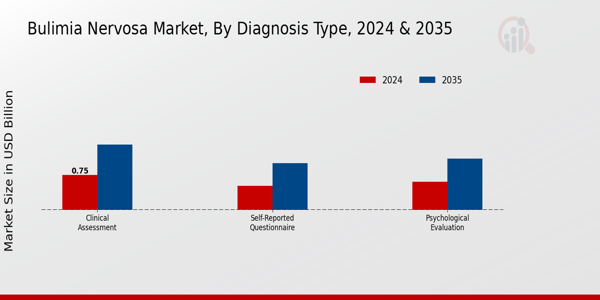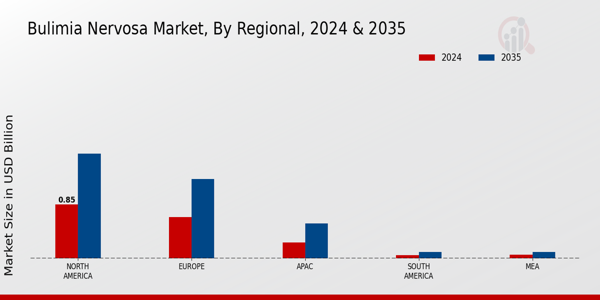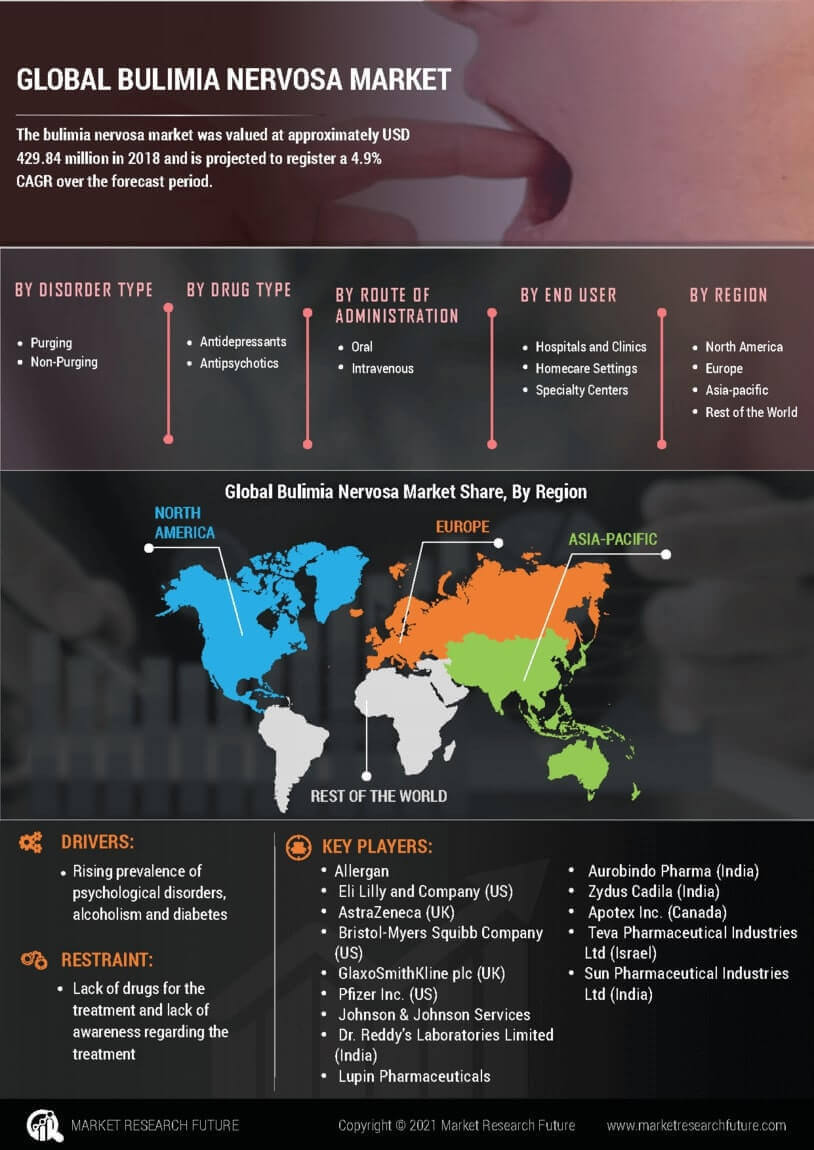Bulimia Nervosa Market Overview
As per MRFR analysis, the Bulimia Nervosa Market Size was estimated at 1.76 (USD Billion) in 2023.The Bulimia Nervosa Market is expected to grow from 1.86(USD Billion) in 2024 to 3.5 (USD Billion) by 2035.
The Bulimia Nervosa Market CAGR (growth rate) is expected to be around 5.89% during the forecast period (2025 - 2035).
Key Bulimia Nervosa Market Trends Highlighted
The increased attention on eating disorders and the growing awareness of mental health issues have a significant impact on the worldwide bulimia nervosa market. One of the main factors driving the market is the increase in bulimia nervosa prevalence across all age categories, but especially among teenagers and young adults.
As a result, early diagnosis and treatment are now given priority in healthcare systems, which eventually improves therapeutic results. Better access to treatment choices for individuals with this disease has also been facilitated by a shift towards more inclusive healthcare policies that acknowledge mental health as a component of total health.
Technology integration in treatment protocols is one of the opportunities to be investigated in the global bulimia nervosa market. Telehealth services are becoming more popular because they make it simpler for people to contact medical specialists, allowing for prompt interventions.
Additionally, cutting-edge therapeutic modalities like cognitive-behavioral therapy and dietary counseling are becoming more and more well-liked, opening doors for medical professionals to connect with more people.
Recent trends indicate a notable rise in the creation of all-encompassing treatment plans that concentrate on the psychological and emotional aspects of bulimia in addition to its physical manifestations. Collaboration between healthcare practitioners, educational institutions, and groups that promote mental health awareness has also significantly increased.
In addition to highlighting the need of community involvement in treatment procedures, these partnerships seek to establish supportive environments for those struggling with bulimia nervosa. Due to a concerted effort to better understand and treat this severe mental health issue, the global bulimia nervosa market is poised for growth as these trends continue to change.

Source: Primary Research, Secondary Research, Market Research Future Database and Analyst Review
Bulimia Nervosa Market Drivers
Rising Awareness of Mental Health and Eating Disorders
The Global Bulimia Nervosa Market is witnessing significant growth driven by the increasing awareness surrounding mental health issues, particularly eating disorders such as bulimia nervosa.
According to the World Health Organization, the prevalence of mental health conditions worldwide has increased over the years, leading to a strong demand for treatment options. Approximately 1 in 7 individuals experience mental health disorders globally.
This heightened awareness has led organizations like the National Eating Disorders Association launching campaigns to educate the public. As such, improved awareness translates into more individuals seeking help, which actively propels the growth of the Global Bulimia Nervosa Market.
Advancements in Treatment Options
The Global Bulimia Nervosa Market is also boosted by advancements in treatment methodologies including both therapeutic and pharmaceutical interventions. Recent statistics indicate that cognitive behavioral therapy has shown effectiveness in about 80% of patients with bulimia nervosa.
According to public health records, countries have begun implementing innovative treatment programs that integrate technology, such as teletherapy, making mental health services more accessible. Renowned organizations like the American Psychological Association support these initiatives, indicating a vital trend towards diversified treatment options serving to expand the Global Bulimia Nervosa Market.
Supportive Regulatory Environment
The regulatory environment plays a crucial role in the expansion of the Global Bulimia Nervosa Market. Recent legislation in various countries focusing on mental health funding is paving the way for better treatment access.
For instance, the Mental Health Reform Bill in nations such as Australia has seen funding increase for mental health-related initiatives, leading to improved service availability. This shifts towards increased support from governmental bodies aims to provide resources necessary for treating eating disorders effectively, thus stimulating market growth.
Bulimia Nervosa Market Segment Insights
Bulimia Nervosa Market Diagnosis Type Insights
The Global Bulimia Nervosa Market’s Diagnosis Type segment consisted of vital categories that played a critical role in the detection and evaluation of the disorder, significantly contributing to the overall market revenue.
In this sector, Clinical Assessment stood out as the leading approach, recording a value of 0.75 USD Billion in 2024, and anticipated to grow to 1.4 USD Billion by 2035. This method was pivotal as it provided healthcare professionals with a structured way to evaluate the physical and emotional conditions of individuals suffering from bulimia nervosa, ensuring proper diagnoses and tailored treatment plans.
Following closely was the Psychological Evaluation segment, valued at 0.6 USD Billion in 2024, expected to increase to 1.1 USD Billion by 2035. This segment was crucial for understanding the underlying psychological factors that contribute to bulimia nervosa, bridging the gap between mental health and eating disorders.
Finally, the Self-Reported Questionnaire segment, which recorded a value of 0.51 USD Billion in 2024, is projected to reach 1.0 USD Billion in 2035. This method empowered individuals to self-assess their experiences, thus playing an important role in early diagnosis and encouraging treatment-seeking behavior.
While all sub-categories hold significance, Clinical Assessment dominates due to its comprehensive nature, providing the foundation for effective intervention and management. The growth in these areas reflects the increasing awareness of bulimia nervosa and the importance of early and accurate diagnosis in improving patient outcomes globally.
Given the projected growth of these segments, the Global Bulimia Nervosa Market is expected to become increasingly essential in addressing the challenges that accompany this eating disorder, ultimately yielding opportunities for innovations in diagnosis and treatment methodologies.

Source: Primary Research, Secondary Research, Market Research Future Database and Analyst Review
Bulimia Nervosa Market Treatment Type Insights
The Global Bulimia Nervosa Market, particularly within the Treatment Type segment, is poised for significant growth as awareness and treatment options expand.
Treatment modalities such as Psychotherapy, Medication, Nutritional Counseling, and Support Groups each play a critical role in patient recovery. Psychotherapy often serves as a foundational treatment, addressing underlying psychological factors vital for long-term recovery.
Medication may help manage symptoms, while Nutritional Counseling provides essential education on healthy eating habits, a crucial element in the recovery process. Support Groups offer crucial peer support, aiding individuals in their journey by sharing experiences and strategies.
The growth of this market segment is driven by the rising prevalence of bulimia nervosa globally and the improved understanding of mental health, leading to better treatment access. Furthermore, the Global Bulimia Nervosa Market statistics indicate a trend towards integrating these treatment types for a holistic approach, which is essential for effective management and recovery.
As initiatives promoting mental health awareness gain momentum, the market is expected to adapt and innovate, further enhancing treatment options for those affected.
Bulimia Nervosa Market Age Group Insights
The Global Bulimia Nervosa Market is poised for considerable growth driven by an increasing understanding of the disorder across various age groups. The market segmentation reveals significant insights within the age categories of Children, Adolescents, Adults, and Older Adults, which collectively represent the diverse demographic affected by bulimia nervosa.
Adolescents play a crucial role in this market, as they form a substantial portion of those diagnosed, often leading to early intervention efforts. Adults, possessing the highest prevalence rates, highlight the necessity for adult-focused treatment and support systems.
Older adults, while a smaller segment, are increasingly recognized for their unique challenges related to the disorder, often overlooked in earlier assessments. The ongoing trends focus on improving accessibility to care and launching awareness campaigns aimed at educating families and communities regarding bulimia nervosa.
These initiatives contribute to the overall growth of the Global Bulimia Nervosa Market, fostering hope for better management of the condition and further driving research and development in the field. By addressing the needs of these specific age groups, the industry can ensure better support for individuals across their lifespan.
Bulimia Nervosa Market Gender Insights
The Global Bulimia Nervosa Market segment focused on Gender reveals significant insights about the differing prevalence and treatment approaches for the condition. The market statistics indicate that women largely dominate the demographic affected by bulimia nervosa, highlighting the need for targeted treatment and support services tailored to their specific experiences.
Nevertheless, the emergence of bulimia nervosa among males and non-binary individuals is increasingly acknowledged, indicating a shifting landscape that requires inclusive strategies.
As societal perceptions evolve, the opportunities for understanding and treatment of bulimia nervosa expand. Factors driving growth in this market include the rising awareness of mental health issues, increased accessibility of healthcare services, and a demand for specialized therapies.
However, challenges persist in providing adequate resources and support for all gender identities, as stigma and underreporting remain prevalent. Understanding the dynamics of the various gender segments will be essential for stakeholders aiming to improve healthcare outcomes in the Global Bulimia Nervosa Market.
Bulimia Nervosa Market Regional Insights
The Global Bulimia Nervosa Market showcased significant regional segmentation, with North America was the dominant region, holding a valuation of 0.85 USD Billion in 2024, rising to 1.65 USD Billion by 2035. This region showcased a major emphasis on mental health awareness and treatment options.
Europe followed closely, valued at 0.65 USD Billion in 2024 and projected to reach 1.25 USD Billion by 2035, benefitting from substantial healthcare policies focused on mental health. The Asia-Pacific (APAC) region, despite being smaller at 0.25 USD Billion in 2024 and 0.55 USD Billion in 2035, represented a growing market due to increasing incidences of eating disorders and rising awareness.
South America and the Middle East and Africa (MEA) respectively held smaller market shares at 0.05 USD Billion and 0.06 USD Billion in 2024, with values of 0.1 USD Billion projected for both by 2035. While these regions had lower contributions, they presented significant opportunities for market growth as mental health initiatives became a focus area.
Overall, the regional landscape of the Global Bulimia Nervosa Market reflected varied growth dynamics and significant potential across different geographical segments, driven by increased awareness and healthcare investments.

Source: Primary Research, Secondary Research, Market Research Future Database and Analyst Review
Bulimia Nervosa Market Key Players and Competitive Insights
The Global Bulimia Nervosa Market is characterized by a complex interplay of various key players striving to address the challenges posed by this serious eating disorder. As the demand for effective treatment options continues to grow, companies are focusing on innovative therapies and a better understanding of the underlying causes of bulimia nervosa.
Competitive insights illuminate the strategies employed by top contenders in the market, including the adoption of advanced research and development initiatives, partnerships, and collaborations aimed at improving patient outcomes.
A primary focus remains on enhancing product offerings, which not only encompass pharmacological interventions but also holistic treatment approaches that cater to the psychological aspects of the disorder. As the market evolves, the emphasis on patient-centric solutions and responsive care is becoming increasingly prominent, allowing stakeholders to gain a significant competitive edge.
Pfizer has emerged as a formidable player in the Global Bulimia Nervosa Market, leveraging its extensive pipeline of pharmaceuticals to cater to the specific needs arising from the disorder.
With a robust portfolio that often encompasses psychiatric medications and therapies aimed specifically at eating disorders, Pfizer is committed to addressing the complexities of bulimia nervosa through research and development.
The company's ability to implement tailored treatment regimens, along with extensive clinical trials, contributes not only to its strong market presence but also establishes trust among healthcare professionals and patients alike.
Additionally, Pfizer's strategic alliances and collaborations with mental health organizations position it effectively within the global landscape, enabling it to reach a wider audience and deliver comprehensive care options that resonate with patient needs.
Merck and Co. also plays a significant role within the Global Bulimia Nervosa Market, focusing on advancing treatment solutions through innovative pharmacological developments. Merck boasts a diverse array of key products and services that are critical in managing bulimia nervosa, with an emphasis on medications that target co-morbid psychiatric conditions often associated with the disorder.
The company has established itself as a leader through its investment in cutting-edge research and the recognition of the multifaceted challenges faced by individuals suffering from bulimia. Furthermore, Merck’s proactive approach in mergers and acquisitions, targeting complementary organizations specializing in mental health, has strengthened its pipeline and market reach.
The company's strengths lie in its strong brand reputation, extensive distribution networks, and ongoing commitment to delivering impactful solutions that not only treat bulimia nervosa but also facilitate a broader understanding of mental health issues globally.
Key Companies in the Bulimia Nervosa Market Include
- Pfizer
- Merck and Co.
- McKesson Corporation
- Takeda Pharmaceutical Company
- AbbVie
- Novo Nordisk
- Otsuka Pharmaceutical
- Johnson and Johnson
- Roche Holding AG
- Teva Pharmaceutical Industries
- BristolMyers Squibb
- AstraZeneca
- GlaxoSmithKline
- Eli Lilly and Company
- Sanofi
Bulimia Nervosa Market Developments
Recent developments in the Global Bulimia Nervosa Market indicate increased awareness and initiatives aimed at improving treatment options and patient care. Pharmaceutical companies including Pfizer, AbbVie, and Otsuka Pharmaceutical are focusing on Research and Development to produce innovative therapies targeting bulimia nervosa.
In December 2022, Takeda Pharmaceutical Company announced the advancement of its treatment pipeline, enhancing options available for patients. Current affairs involve an emphasis on mental health integration in healthcare services, reflecting a broader societal commitment to address eating disorders comprehensively.
Merger and acquisition activities have been significant, with Bristol-Myers Squibb acquiring Celgene in January 2021, further enhancing its position in therapeutic offerings related to mental health. Additionally, a growing emphasis on personalized medicine has been noted, particularly from companies like Johnson and Johnson and Roche Holding AG, as they explore novel approaches to treatment.
Valuations in the Global Bulimia Nervosa Market have witnessed growth as demand for effective treatment solutions increases, leading to heightened investment in this area. Over the last two to three years, significant attention to digital health solutions reflecting in market dynamics has surged, representing a fundamental shift towards innovative patient engagement strategies.
Bulimia Nervosa Market Segmentation Insights
Bulimia Nervosa Market Diagnosis Type Outlook
- Clinical Assessment
- Psychological Evaluation
- Self-Reported Questionnaire
Bulimia Nervosa Market Treatment Type Outlook
- Psychotherapy
- Medication
- Nutritional Counseling
- Support Groups
Bulimia Nervosa Market Age Group Outlook
- Children
- Adolescents
- Adults
- Older Adults
Bulimia Nervosa Market Gender Outlook
Bulimia Nervosa Market Regional Outlook
- North America
- Europe
- South America
- Asia Pacific
- Middle East and Africa
| Report Attribute/Metric Source: |
Details |
| MARKET SIZE 2023 |
1.76(USD Billion) |
| MARKET SIZE 2024 |
1.86(USD Billion) |
| MARKET SIZE 2035 |
3.5(USD Billion) |
| COMPOUND ANNUAL GROWTH RATE (CAGR) |
5.89% (2025 - 2035) |
| REPORT COVERAGE |
Revenue Forecast, Competitive Landscape, Growth Factors, and Trends |
| BASE YEAR |
2024 |
| MARKET FORECAST PERIOD |
2025 - 2035 |
| HISTORICAL DATA |
2019 - 2024 |
| MARKET FORECAST UNITS |
USD Billion |
| KEY COMPANIES PROFILED |
Pfizer, Merck and Co., McKesson Corporation, Takeda Pharmaceutical Company, AbbVie, Novo Nordisk, Otsuka Pharmaceutical, Johnson and Johnson, Roche Holding AG, Teva Pharmaceutical Industries, BristolMyers Squibb, AstraZeneca, GlaxoSmithKline, Eli Lilly and Company, Sanofi |
| SEGMENTS COVERED |
Diagnosis Type, Treatment Type, Age Group, Gender, Regional |
| KEY MARKET OPPORTUNITIES |
Increased awareness campaigns, Digital therapy solutions, Nutritional support programs, Telehealth treatment options, Personalized medicine advancements |
| KEY MARKET DYNAMICS |
Increasing prevalence of bulimia, Growing awareness and diagnosis, Advancements in treatment options, Rising mental health focus, Expansion of telehealth services |
| COUNTRIES COVERED |
North America, Europe, APAC, South America, MEA |
Frequently Asked Questions (FAQ):
The projected market size of the Global Bulimia Nervosa Market by 2024 is expected to be valued at 1.86 USD Billion.
By 2035, the Global Bulimia Nervosa Market is expected to reach a value of 3.5 USD Billion.
The expected CAGR for the Global Bulimia Nervosa Market from 2025 to 2035 is 5.89%.
North America is expected to have the largest market share by 2035, valued at approximately 1.65 USD Billion.
The market value of the Global Bulimia Nervosa Market in Europe for the year 2024 is projected to be 0.65 USD Billion.
Major players in the Global Bulimia Nervosa Market include Pfizer, Merck and Co., and McKesson Corporation.
The Clinical Assessment segment of the Global Bulimia Nervosa Market is expected to be valued at 1.4 USD Billion by 2035.
The Psychological Evaluation segment of the Global Bulimia Nervosa Market is projected to be worth approximately 1.1 USD Billion by 2035.
The APAC region is expected to grow to a market value of around 0.55 USD Billion by 2035.
The growth drivers influencing the Global Bulimia Nervosa Market include increased awareness of mental health and advancements in treatment options.


















